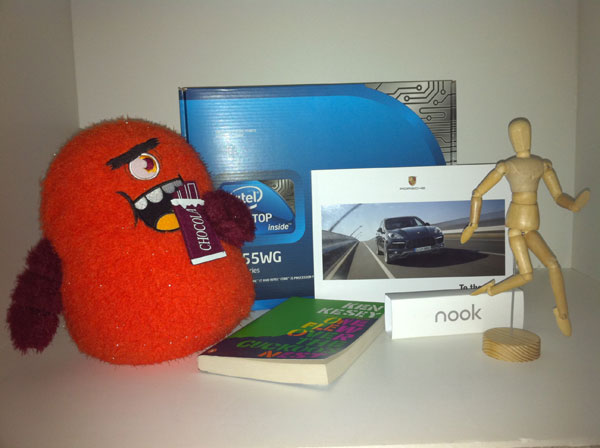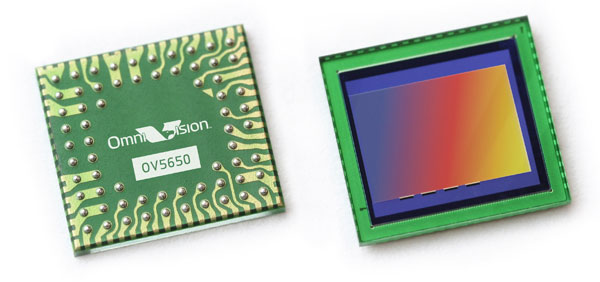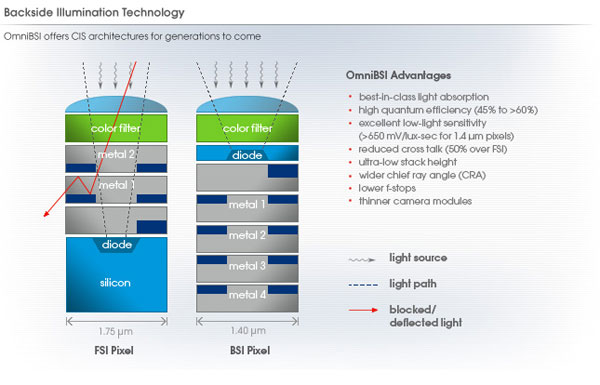Apple's iPhone 4: Thoroughly Reviewed
by Brian Klug & Anand Lal Shimpi on June 30, 2010 4:06 AM EST- Posted in
- Smartphones
- Apple
- iPhone 4
- Gadgets
- Mobile
Welcome to 2010, Apple Upgrades its Camera
The iPhone 4 is equipped with two cameras: a 5 megapixel camera with LED flash on the back of the phone and a VGA camera with no flash on the front. The LED flash works in both still and video modes. Like the EVO 4G, the iPhone 4‘s flash allows you to shoot in perfect darkness. If you’re filming a video in low light the LED will stay illuminated while you’re recording.

Taken with the iPhone 4 in total darkness
The same unfortunately can’t be said for the front facing camera on the 4. In anything but good lighting you’re going to get noise. It’s really only useful for FaceTime (or as an alternative to a mirror) and even then you need to be well lit for it to look decent.
Apple has opted for a 5 megapixel OmniVision sensor for the rear camera on the iPhone 4. What's interesting is that Apple has decided to bring backside illumination front and center with their marketing.
Backside illumination improves the sensitivity of CMOS and CCD detectors by reducing the amount of material in the path of incident light. In a frontside illuminated detector, a considerable amount of light is lost due to absorption that doesn't result in emission of an electron, in addition to reflection off pixel structures and electrical components near the frontside surface. Backside illumination greatly improves sensitivity by flipping the stack over. Instead of light having to pass through and possibly be reflected by metal structures, it is converted into electrons and read out by passing solely through silicon. Creating a backside illuminated part isn't as simple as flipping a sensor over, however, as manufacturers also generally thin the silicon light has to pass through before it can reach the photodiode. This further improves sensitivity and is generally accomplished through chemical etching in acid or by lapping (physically grinding) sensors at wafer scale.

OmniVision OV5650 - iPhone 4's rear camera SoC
Though backside illumination (BSI) improves quantum efficiency (how many photons are converted into electons), backside illumination is hugely important for another serious reason as well. Because the sensor is small at 4.6 mm by 3.4 mm, pixel size is also extremely small at just 1.75 microns square for the OV5650 in the iPhone 4 (state of the art sensors are 1.4 microns square, like those in the HTC Incredible's 8 MP sensor). Frontside illuminated parts generally have in the neighborhood of 10-15 microns of silicon before the active region of the photodiode where one wants photons to get converted to electrons. The result is that without backside illumination, pixels have a 10:1 ratio of height to length, you can visualize them as looking something like long square pillars. But that's a problem.
As photons are converted into electrons in that silicon, there's no guarantee that it will immediately travel down into the gate structure below to be read out by the camera. Electrons drift as they descend these columns, meaning that photons incident on one pixel don't necessarily map to the gate below. Because the smartphone camera sensors are so small, with a 10:1 ratio of height to size, the result is large amounts of so-called quantum blurring from electrons traveling into the gate structures of adjacent pixels. The result is a blurry image (and a decrease in MTF at the sensor level!), thus not representing the image that used to be incident on the sensor.
OmniVision and other smartphone CMOS sensor manufacturers thin that column down in an effort to come closer to having the pixel look more like a cube than a huge pillar. Ballpark numbers are between 3 and 6 microns, down from 10-15. The result is much more sensitive sensors that are higher resolution. While megapixels don't necessarily matter, neither does pixel size as much anymore; it's all about quantum efficiency, which is what engineers really care about.

OmniVision BSI - Courtesy OmniVision
The optical system of the iPhone 4 is difficult to characterize without disassembly, though the focal length is a bit shorter than previous iPhones. The result is that the photos are demonstrably wider angle. Backside illumination also allows for a bigger chief ray angle, higher numerical aperture (and thus lower f/#), but I won't bore you with the details.










270 Comments
View All Comments
Brian Klug - Wednesday, June 30, 2010 - link
I just used the data I had in my bench for the Nexus One, but retesting with Froyo is coming soon since the OTA final update only got pushed out final yesterday. I've been holding off waiting for that final.-Brian
vlntwarrior - Wednesday, June 30, 2010 - link
The drop in signal from cupping the device with a case on is purely a function of us being "ugly bags of mostly water."and I thought I was the only geek to randomly quote this line in normal everyday conversation
JP_Lager - Wednesday, June 30, 2010 - link
From the article regarding the Apple Bumper Case..Third party connectors will not fit, I had the same issue.
To fix just take a nail file and file the edge so it is at a slight angle all around. Takes about 2-3 min to do, now all my third party accessories will connect and lock with no problem.
JP
Lothsahn - Wednesday, June 30, 2010 - link
"ugly bags of mostly water""going places no iPhone had ever gone before"
Anyone else see any Star Trek references I missed?
Lothsahn
rs1 - Wednesday, June 30, 2010 - link
"The main downside to the iPhone 4 is the obvious lapse in Apple's engineering judgment."I think you're giving their engineering and marketing departments too little credit. If anything, I would think that the antenna placement and all-glass construction were intentional design decisions stipulated by marketing, so that they could sell a $30 piece of rubberized plastic. It's quite clever, really. Completely lacking in moral sense, but clever nonetheless.
Toadster - Wednesday, June 30, 2010 - link
just kidding! (well, maybe not)Great writeup! Keep em coming!
balazer - Wednesday, June 30, 2010 - link
This article has sloppy use of power units.dBm is an absolute measure of power. Thus, you could say a received signal is -119 dBm.
dB is a relative measure of power - a logarithmic representation of a factor. Thus, you could say that one signal is 10 dB stronger than another, which is to say that one signal is 10 times as strong as the other. (20 dB is 100 times as strong; 30 dB is 1000 times as strong, etc.)
The difference between -109 dBm and -119 dBm is 10 dB, not 10 dBm. 10 dBm is actually much more power than the difference between -109 dBm and -119 dBm.
Brian Klug - Wednesday, June 30, 2010 - link
The funny part is that I did it the right way the first time, and then changed it hastily. Fixed!-Brian
Janet55 - Wednesday, June 30, 2010 - link
Nice and insightful review!My new iphone is fantastic...
The picture definition ...I'm speachless....personally I really like the grouping of apps much tidier than before and the camera zoom. And I have no signal problem yet, I have held it in the way which is supposed to drop the signal several times and only notice the signal drop once.
I showed the phone to my team at work and let them play with it...they all love it and there are a few green eyes I can assure you.
As the iPhone 4 high-definition video clips, watch video on IPhone 4 must be cool and amazing, I've been looking for a good program to Convert videos or rip DVD movies for the iPhone 4 and i think iFunia iPhone 4 Video Converter is the one which worth trying, Im ready for enjoying on the go!
I am very pleased, it's expensive but it actually feels worth it. can't recommended it enough. Gorgeous to look at and an absolute pleasure to use.
Cr0nJ0b - Wednesday, June 30, 2010 - link
I haven't seen this widely reported...and I sort of expected this when i did the update...but my company of 20,000+ is having HUGE exchange issues related to iphone users who upgraded to IOS4. I'm not sure exactly what the issue is, but I'm guessing it has to do with ActiveSync. It puts a LOT of stress on the servers...in fact, my corp has asked us to avoid upgrading if we haven't done so yet. They also say that there is a patch on the Apple website, but it hasn't been tested, so they are asking for more time.